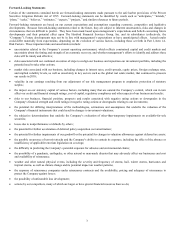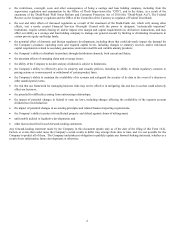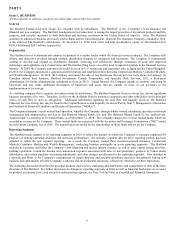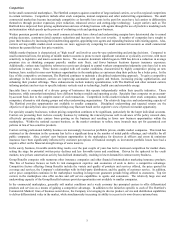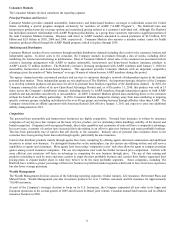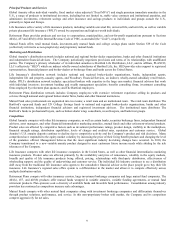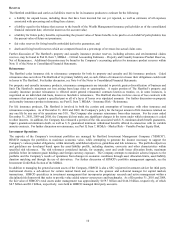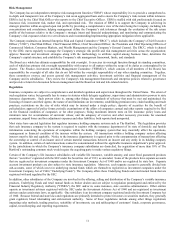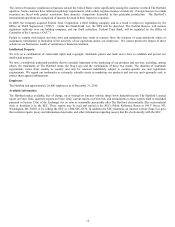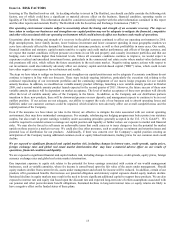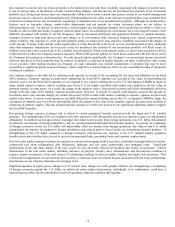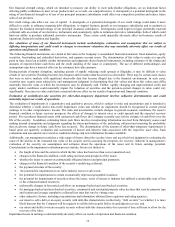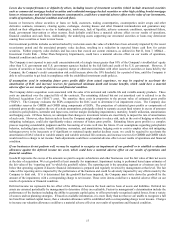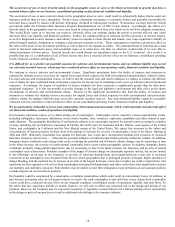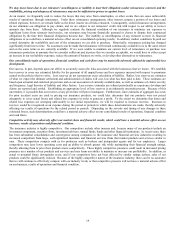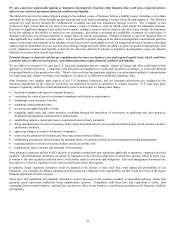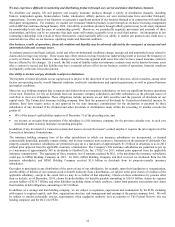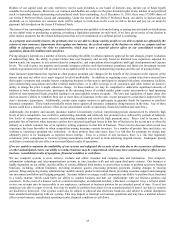The Hartford 2010 Annual Report Download - page 13
Download and view the complete annual report
Please find page 13 of the 2010 The Hartford annual report below. You can navigate through the pages in the report by either clicking on the pages listed below, or by using the keyword search tool below to find specific information within the annual report. 13
Item 1A. RISK FACTORS
Investing in The Hartford involves risk. In deciding whether to invest in The Hartford, you should carefully consider the following risk
factors, any of which could have a significant or material adverse effect on the business, financial condition, operating results or
liquidity of The Hartford. This information should be considered carefully together with the other information contained in this report
and the other reports and materials filed by The Hartford with the Securities and Exchange Commission (“SEC”).
Our operating environment remains subject to uncertainty about the timing and strength of an economic recovery. The steps we
have taken to realign our businesses and strengthen our capital position may not be adequate to mitigate the financial, competitive
and other risks associated with our operating environment which could adversely affect our business and results of operations.
Uncertainty about the timing and strength of a recovery in the global economy continued to affect our operating environment in 2010.
High unemployment, lower family income, lower business investment and lower consumer spending in most geographic markets we
serve have adversely affected the demand for financial and insurance products, as well as their profitability in some cases. Our results,
financial condition and statutory capital remain sensitive to equity and credit market performance and effects of foreign currency, and
we expect that market conditions will put pressure on returns in our life and property and casualty investment portfolios and that our
hedging costs will remain higher than historical levels. Unless all economic conditions continue to improve, we would expect to
experience realized and unrealized investment losses, particularly in the commercial real estate sector where market value declines and
risk premiums still exist, which reflects the future uncertainty in the real estate market. Negative rating agency actions with respect to
our investments could also indirectly adversely affect our statutory capital and risk-based capital (“RBC”) ratios, which could in turn
have other negative consequences for our business and results.
The steps we have taken to realign our businesses and strengthen our capital position may not be adequate if economic conditions do not
continue to improve in line with our forecasts. These steps include ongoing initiatives, particularly the execution risk relating to the
continued repositioning of our investment portfolios and the continuing realignment of our macro hedge programs for our variable
annuity business. In addition, we modified our variable annuity product offerings, launching a new variable annuity product in October
2009, and a second variable annuity product launch expected in the second quarter of 2011. However, the future success of these new
variable annuity products will be dependent on market acceptance. The level of market acceptance of these new products will directly
affect the level of variable annuity sales of the Company in the future. In addition, as the Company and our distribution partners
transition to these new products, there will be downward pressure on new deposits, and management expects to continue to be in a net
outflow position. If our actions are not adequate, our ability to support the scale of our business and to absorb operating losses and
liabilities under our customer contracts could be impaired, which would in turn adversely affect our overall competitiveness and the
capital position of the Company.
Even if the measures we have taken (or take in the future) are effective to mitigate the risks associated with our current operating
environment, they may have unintended consequences. For example, rebalancing our hedging program may better protect our statutory
surplus, but also result in greater earnings volatility under accounting principles generally accepted in the U.S. (“U.S. GAAP”). We
could be required to consider actions to manage our capital position and liquidity or further reduce our exposure to market and financial
risks. We may also be forced to sell assets on unfavorable terms that could cause us to incur charges or lose the potential for market
upside on those assets in a market recovery. We could also face other pressures, such as employee recruitment and retention issues and
potential loss of distribution for our products. Additionally, if there was concern over the Company’ s capital position creating an
anticipation of the Company issuing additional common stock or equity linked instruments, trading prices for our common stock could
decline.
We are exposed to significant financial and capital markets risk, including changes in interest rates, credit spreads, equity prices,
foreign exchange rates and global real estate market deterioration that may have a material adverse effect on our results of
operations, financial condition and liquidity.
We are exposed to significant financial and capital markets risk, including changes in interest rates, credit spreads, equity prices, foreign
currency exchange rates and global real estate market deterioration.
One important exposure to equity risk relates to the potential for lower earnings associated with certain of our wealth management
businesses, such as variable annuities, where fee income is earned based upon the fair value of the assets under management. Should
equity markets decline from current levels, assets under management and related fee income will be reduced. In addition, certain of our
products offer guaranteed benefits that increase our potential obligation and statutory capital exposure should equity markets decline.
Sustained declines in equity markets may result in the need to devote significant additional capital to support these products. We are also
exposed to interest rate and equity risk based upon the discount rate and expected long-term rate of return assumptions associated with
our pension and other post-retirement benefit obligations. Sustained declines in long-term interest rates or equity returns are likely to
have a negative effect on the funded status of these plans.


